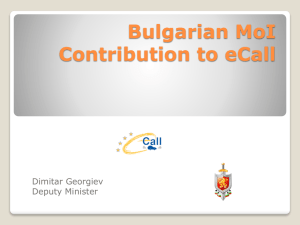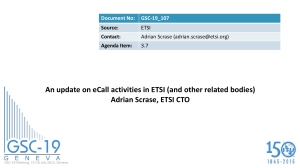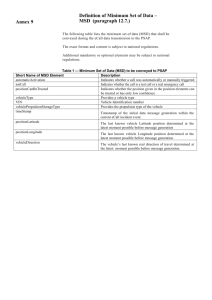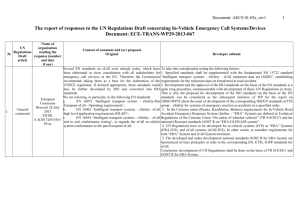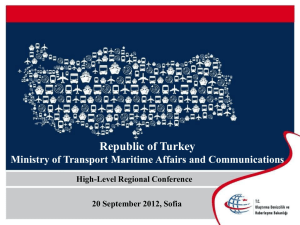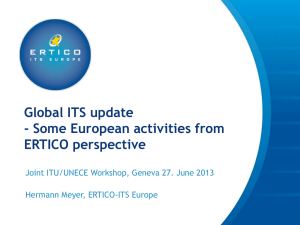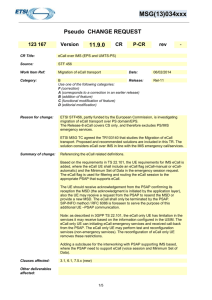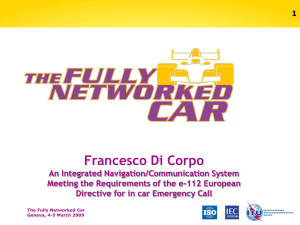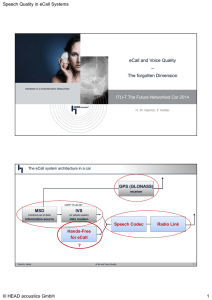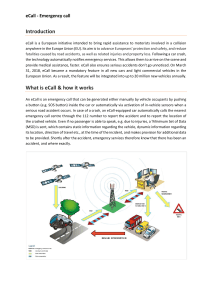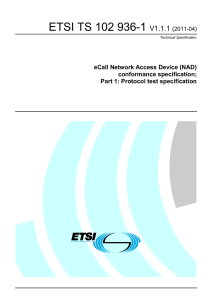Creating momentum towards the networked car eCall:
advertisement
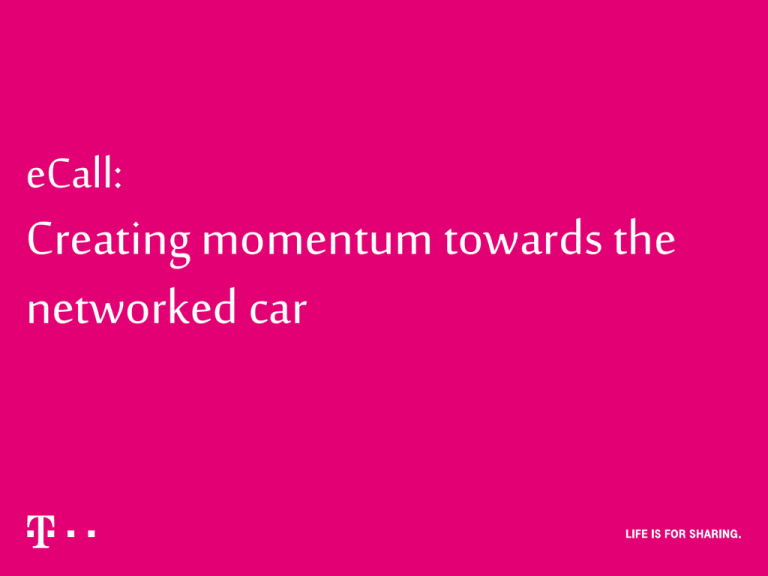
eCall: Creating momentum towards the networked car What is Pan European eCall ? Pan European eCall is a further development of traditional emergency call using the emergency number 112 and is thus free of charge Pan European eCalls are either generated manually or automatically When activated a voice connection with the most appropriate Public Safety Answering Point (PSAP) is established At the same time a minimum set of data (MSD) is sent using the voice channel to the PSAP operator receiving the voice call The MSD contains vital data such as the current GPS location coordinates, incident time and vehicle description. MSD = minimum set of data PSAP = public safety answering point Source: European Commission 2 Pan European eCall, Technical Bits Whereas the implementation of the Pan European eCall service is at European level, a harmonised approach respecting the different national implementations, interoperability and cross border continuity, the eCall service will use the common European standards as defined by ETSI and CEN* Pan European eCall transmission is piggybacking on the standards of traditional emergency calls (TS12). This ensures maximum Grade of Service For the sake to be able to distinguish traditional emergency calls from eCalls, 3GPP/ ETSI standardized the “eCall Flags” (ETSI TS 124 008 / 3GPP TS 24.008) *a List of relevant eCall Standards is contained in the backup 3 What is managed eCall ? Managed eCalls are proprietary solutions which from a customers perspective provide basically an equivalent service Managed eCalls are part of a bundle services (Concierge Service, Breakdown Service…) Managed eCalls are based on common numbers (not 112) When activated a voice connection to a service centre is established From there: - Emergency calls are forwarded to the appropriate PSAP - Emergency related data is sent either via SMS or proprietary modems using the voice channel 4 The regulatory background A set of proposed legal acts shall ensure the deployment of the 112-based eCall service by 1 October 2015: A proposal for a regulation on the eCall in-vehicle system concerning type-approval requirements for the deployment of the eCall in-vehicle system. The purpose of this proposal is to introduce a requirement for fitting an eCall in-vehicle system in the EC motor vehicle type-approval system. The Commission Recommendation 2011/750/EU of 8 September 2011 on support for an EU-wide eCall service in electronic communication networks for the transmission of in-vehicle emergency calls based on 112 (‘eCalls’) A Commission Delegated Regulation (EU) No 305/2013 of 26.11.2012 supplementing Directive 2010/40/EU of the European Parliament and of the Council with regards to the harmonised provision for an interoperable EU-wide eCall 5 Deutsche Telekom engagement for eCall Proactive in relevant Standardization Bodies and at political level Engagement in various Field Trials All mobile Networks in the DT Group will have the eCall flags* be implemented by October 2015 * (ETSI TS 124 008 / 3GPP TS 24.008) 6 Martin Büchter Deutsche Telekom AG Group Technology Landgrabenweg 151, 53227 Bonn +49 228 936-18497 (Tel.) +49 171 5416632 (Mobil) E-Mail: martin.buechter@telekom.de www.telekom.com 31.05.2016 7 Backup 8 eCall Standards (1) Title Description Reference 3rd Generation Partnership Project; Technical Specification Group Services and System Aspects; eCall Data Transfer; In-band modem solution; Characterisation Report (Release 8) eCall Data Transfer – Characterisation Report 3GPP TS 26.969 ETSI TS 126 969 3rd Generation Partnership Project; Technical Specification Group Services and System Aspects; eCall Data Transfer; In-band modem solution; Characterisation Report (Release 8) eCall Data Transfer – Technical Report Characterisation Report 3GPP TR 26.969 ETSI TR 126 969 Road transport and traffic telematics — eSafety — eCall minimum set of data - Draft EN 081018 eCall minimum set of data CEN EN 15722 Intelligent transport systems — eSafety - Pan European eCall – Operating requirements Pan European eCall Operating Requirements CEN EN 16072 Intelligent Transport Systems - eCall – High Level Application Protocols High Level Application Protocols CEN EN 16062 Intelligent transport systems - ITS Safety and emergency messages using any available wireless media - Data registry procedures Data registry procedures ISO/EN 24978:2009 9 eCall Standards (2) Title Description Reference 3rd Generation Partnership Project; Technical Specification Group Services and System Aspects Service aspects; Service principles (Release 9) eCall requirements for data transmission 3GPP TS 22.101 ETSI TS 122 101 3rd Generation Partnership Project; Technical Specification Group Core Network and Terminals; Mobile radio interface Layer 3 specification; Core network protocols; Stage 3 (Release 8) eCall Discriminator Table 10.5.135d 3GPP TS 24.008 ETSI TS 124 008 3rd Generation Partnership Project; Technical Specification Group Services and System Aspects; eCall Data Transfer; In-band modem solution; General description (Release 8) eCall Data Transfer – General Description 3GPP TS 26.267 ETSI TS 126 267 3rd Generation Partnership Project; Technical Specification Group Services and System Aspects; eCall Data Transfer; In-band modem solution; ANSI-C reference code (Release 8) eCall Data Transfer ANSI-C Reference Code 3GPP TS 26.268 ETSI TS 126 268 3rd Generation Partnership Project; Technical Specification Group Services and System Aspects; eCall Data Transfer; In-band modem solution; Conformance testing (Release 8) eCall Data Transfer – Conformance Testing 3GPP TS 26.269 ETSI TS 126 269 10
